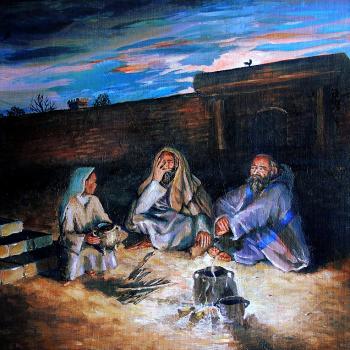I had a student in class who questioned how I could say that the gospel was the same throughout the Bible. He said the gospel seems very different in the Old Testament, Jesus’ preaching, and in Paul’s letters.
At that moment, I came up with an analogy. Tell me what you think. Different periods of gospel preaching could be compared to a woman’s pregnancy.
1. Birth Announcement (Promise)
In the Old Testament, the gospel preached beforehand (cf. Gal 3:8; Isa 52:7) was a birth announcement. A child will be born. This is God’s promise to be fulfilled (cf. Acts 13:32–33; Rom 1:1–4; 1 Cor 15:1–8, 20–28).
2. Conception (Inauguration)
Jesus’ gospel announced that the promised child has been conceived. This is beginning of the pregnancy so get ready.
3. Third-Trimester (A Call to the World)
Paul and the Church, since Jesus ascended, preached the same gospel, however, the pregnancy is now in its 3rd trimester––the last days have arrived. Delivery is near!
Each of these gospel announcements points to the birth of a child. What is this child? It is the kingdom of God fully manifest on earth as it is in heaven. This is simply the New Creation––a new heaven and new earth where righteousness reigns in Christ Jesus. Fundamentally, each gospel presentation points to the same reality told from different points in time.
Paul seems to have this same sort of imagery in mind.
Romans 8:22, “For we know that the whole creation has been groaning together in the pains of childbirth until now” (ESV).
Galatians 4:19, “…my little children, for whom I am again in the anguish of childbirth until Christ is formed in you!” (ESV).
Pregnant Women are Beautiful, But So Is the Gospel
One reason this entire question matters is because people struggle to reconcile the seemingly different ways the Bible talks about the gospel. If a person can’t make sense of some pretty different passages, he or she will give up on the question “What is the gospel?” Consequently, people will eventually settle for whatever their tradition says is the gospel.
Try for example to fit neatly together the following gospel-passages: Isaiah 52:7, Mark 1:14–15, Galatians 3:8, 1 Corinthians 15:4-8, and Romans 1:2–4, to say nothing of Acts 14, 17.
If you are interested, I published an article on this topic in April. It’s called “Contextualizing the One Gospel in any Culture––A Model from the Biblical Text for a Global Context.”
By the way, Christianity Today had an article on this topic a few year back called “Jesus vs. Paul.” Trevin Wax interviewed Scot McKnight about the article on his blog.













